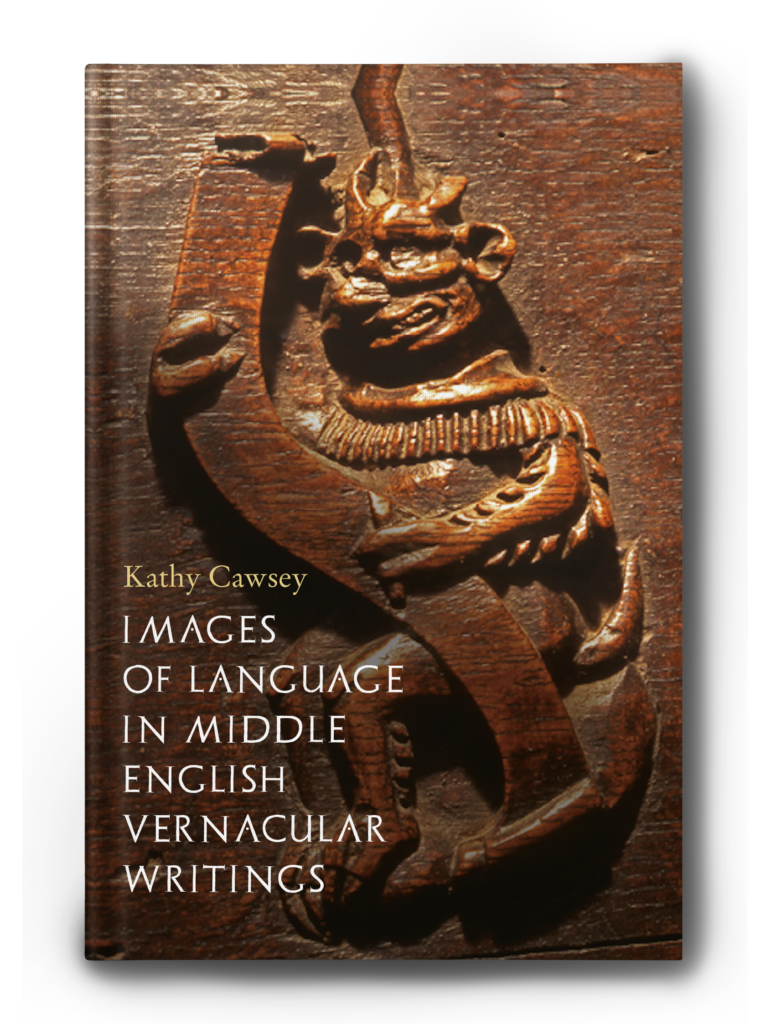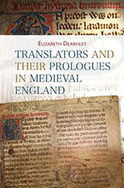
Images of Language in Middle English Vernacular Writings
KATHY CAWSEY
Dr Cawsey, thank you for participating in this interview! To begin with, can you please provide a short summary of your new book Images of Language in Middle English Vernacular Writings?
The book tries to figure out how people in the Middle Ages thought language worked – something called the theory or philosophy of language. The problem medievalists face when dealing with a subject like that, however, is that all the philosophical writing we have from the time is in Latin. So we only have access to what a small portion of the population – educated, mostly male, mostly clerical – thought about language. The second problem is that, more than any other subject, the language in which you think or write runs the risk of affecting or conditioning what you’re able to think or write.
Now, as I said, there’s precious little philosophy of language written in English. But English authors wrote about language all the time – they just did it implicitly, and used metaphors and images. So my book tries to work backwards from those images to figure out what underlying theory of language could have produced those images. To give a modern example, someone who describes language like a computer code probably has a very different underlying understanding of language than someone who describes it as a tree. Images of Languagetries to reverse-engineer the images to figure out what individual writers in Middle English thought about how language works. And because there wasn’t an explicit, coherent, thought-through philosophy of language in English the way there was in Latin, the book takes representative cases and tries to tease out the implications of those.
Exploring how English writers thought language works in the Middle Ages is a fascinating topic. Is there any part of your research that explicitly stood out to you?
The character on the front of my book is always the one I talk about when I’m talking to non-medievalists – Tutivillus, the demon who runs around picking up the syllables monks drop and mumble when they say their prayers or reciting the church service. But what’s fascinating, and what no one before me has really explored, is there are actually two strands of the Tutivillus stories: the one with the monks, and then another strand where Tutivillus writes down women’s gossip in church. On the surface they seem similar, but when you think about the images of language, they’re actually startlingly different. The image of language in the tales with the women gossips is similar to our image of writing – the demon hears the gossip and records it on parchment with a pen. The image in the stories of the monks, though, is different: in this case, language has substance and weight; it falls, Tutivillus can pick it up and put it in a sack on his back, it is stored and brought back out on Judgment Day. When I was thinking about why these images were so different, and so distinct – Tutivillus never picks up women’s gossip and puts it in his sack, nor does he write down the syllables the monks miss – I realized that in each case, the image of language is related to power the target audience lacks. Women in the Middle Ages lacked access to documentary, literate culture, to the power of the courts and legal systems; monks, on the other hand, lacked material goods and possessions, and the power that comes with wealth. I was floored to discover the subtlety of the stories: they not only tried to control their target audience through the message of the stories – that they would go to hell for disrupting or messing up the church service – but through the very images of language in the tales as well.
Has this been something that you have always been interested in? How did you find the path to this research?
I think I looked back at all my essays and articles at one point, and thought, on the surface these are all on different subjects and texts – from Chaucer to drama to Malory to exempla – but I’m really always writing about the same thing: images of languages and what they can tell us about how people think language works. So I decided I’d better write a book.
Can you tell us more about the case studies you chose to investigate? What made you decide on them in particular?
I tried to cover most of the genres or forms of writing at the time, and also to cover a range of authors – so there’s everything from sermon exempla to drama to dream vision to debate to romance, written by people as high up the social scale as you can find in English (Chaucer) to far lower (popular sermons, romance, drama). But beyond that, I mostly chose images that were particularly interesting and had layers I could explore. Chaucer’s House of Fame had lots of fascinating images of language that came from the Latin philosophers of language, so I started the book with that. The magical golden writing in the Morte Darthur seemed to me to be not just writing but an image of writing, and so I needed a parallel image of speech – and a friend suggested birdsong and bird debates. But it seemed to me that analysing the images of language needed to go beyond just “hey, nifty” – I needed to ask what those images were doing. So the Tutivillus tales and then the play “Mankind” pushed me to explore the political implications of metaphors of language in the last two sections of the book.
Did your findings surprise you?
Some of them did. Before working on this book, I thought Chaucer had a pretty happy-go-lucky attitude to language and writing – I kind of had an image of Chaucer that was similar to the Chaucer character in the movie The Knight’s Tale! My idea of Chaucer was probably influenced a lot by the raunchy stories of The Canterbury Tales, as well as by the fact that he’s so hard to pin down – critics can hardly agree about what he thinks about anything, and I have a mental picture of a mischievous trickster laughing at his readers. However, when I actually looked at what Chaucer did to the Latin images he used, I realized that his images often add an element of danger and uncontrollability to the Latin metaphors. So it’s a Latin commonplace to describe language and the way sound travels through the air by comparing it to fire and smoke rising, and the Eagle says in The House of Fame that “just as fire is lit smoke, right so is sound broken air.” But elsewhere Chaucer speaks of tidings and gossip spreading like wildfire and burning down whole cities. Similarly, he uses an image from Ovid describing the sound of the House of Rumour being like the far-off murmur of the waves – but Chaucer changes it to the beating of a sea when the tempest swallows ships. Ovid says nothing about sinking ships! So in each case, Chaucer makes the transmission of language dangerous. I think that’s really interesting when we think about the transmission and misunderstanding of stories in The Canterbury Tales, or Chaucer’s joking poem about Adam Scriveyn mis-transcribing Troilus and Criseyde. Maybe it wasn’t so joking after all.
I wrote about the sparkling golden writing in Malory years ago, and came back to that for this book. When I first wrote about it, I kind of assumed that golden writing was just part of the magical, fantastical romance landscape in the same way that hermits and magical grafted trees and fairy maidens were. But this time around, I realised that for the most part, golden writing was limited to a few Arthurian texts – The Morte Darthur, the Prose Merlin – and, moreover, that it wasn’t even part of the Arthurian landscape but was only in the texts with Merlin in them. I had to make sense of that.
Will you continue working on similar research? What is next for you?
When I would give papers on this topic, I’d always have people come up to me afterwards and say, “Why didn’t you talk about this?” or “There’s a cool image of language in such-and-such a text.” So if Images does well, I might do a follow-up collection of essays, and invite all those people to contribute articles about their images!
But aside from that, I think I’m ready for a new project. A lot of my ideas come out of my teaching, and lately I’ve been seeing a lot of connections between medieval texts and today – medieval rape and the #metoo movement, romance stalker-heroes and contemporary incels. So either a book or a series of articles on those topics.
We like to finish with the same question to all our contributors. Naturally, we hope you have stayed well throughout the last year but how has your work been affected by lockdowns and restricted access to libraries and archives?
I’m in Nova Scotia, so I’m incredibly blessed – we’ve managed to keep our case count really low. But I’m still teaching entirely online, and I had to cancel a trip to England last summer. Plus, of course, trying to work from home with kids … but I really have nothing to complain about compared with the rest of the world.

222pp
£75/$99, 9781843845720
October 2020
DS Brewer
SPECIAL MEDIEVAL HERALD SUBSCRIBER PRICE:
USE CODE: BB895
Also Available
Save 40% with your Medieval Herald discount
(code BB895)




KATHY CAWSEY is an Associate Professor in the Department of English at Dalhousie University in Halifax, Nova Scotia, Canada.
